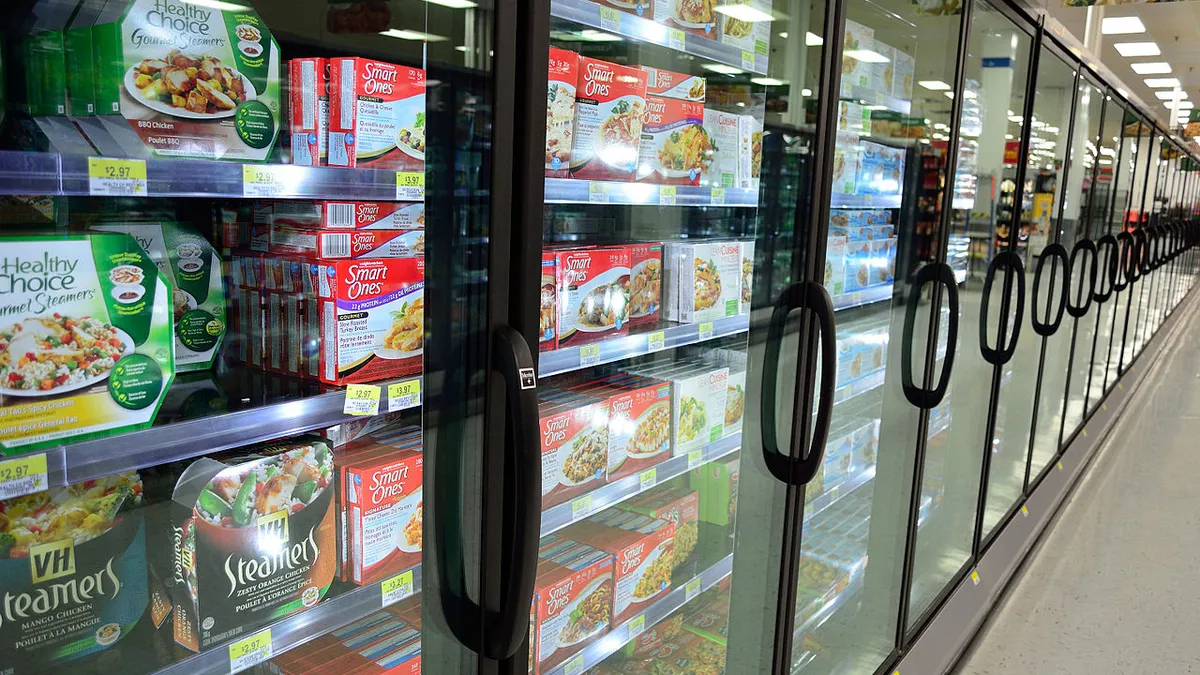Dive Brief:
-
Sales of frozen foods are increasing, thanks to millennials and others seeking out more convenient and less-expensive meal options. Volume this year is growing for the first time since 2013, according to RBC Capital Markets Analyst David Palmer, who was quoted in a story from Bloomberg.
-
Consumers are looking for easy meal solutions — frozen breakfast waffles and frozen pasta entrées are two popular examples. Millennial households shelled out 9% more per shopping trip for frozen foods last year than other groups, Reuters reported.
-
Despite having popular frozen brands such as Lean Cuisine and Hot Pockets, a Nestlé official told Reuters the world's largest food company fell behind in frozen and was unable to adequately respond to increased consumer demand, causing it to lose market share to its rivals.
Dive Insight:
Once left for dead, frozen food sales are heating up. The reason is likely twofold — a shift in consumer trends and a realization by major CPG manufacturers that frozen foods still have a future if only they were given the attention they had been lacking.
The space has rebounded as food manufacturers have innovated brands to include more attributes popular with consumers. Research from Acosta shows that next to convenience, products with labels stating no antibiotics, non-GMO, hormone-free, all-natural, sustainable and low-sodium are key for consumers of frozen foods. The growing demand for convenience and less interest in cooking, especially among millennials, also has helped spur the surge in frozen foods.
“It got sluggish not because people stopped appreciating the convenience of frozen," Sean Connolly, president and CEO of Conagra Foods, said at the Consumer Analyst Group of New York conference in February. "It got sluggish because big companies took their eye off the ball and didn’t modernize their brands with changing consumer tastes.”
A study by sales and marketing agency Acosta found last fall that 26% of U.S. consumers are shopping the frozen foods department more frequently than they did in 2016. All generations reported buying more frozen food, but the increase was driven in large part by millennials, 43% of whom said they bought more frozen foods compared with the prior year.
B&G Foods, for example, posted its fourth consecutive quarter of double-digit growth in net sales of Green Giant frozen selections, driving by the popularity of new Veggie Sprials, Riced Veggies, Veggie Tots and Mashed Cauliflower. B&G Foods has been rejuvenating the Green Giant brand it acquired from General Mills in 2015 for $765 million.
Banquet, which Connolly said had "packaging that looked like it was from the 80s," was refreshed, and a new premium "mega" tier for people with big appetites, especially popular among the millennial crowd, was added. It also introduced cheeseburger and hot chicken sliders to cater to the on-the-go consumer craving protein. Sales for the Banquet brand responded, jumping 6% from the prior year. Similar improvements were made in its Healthy Choice brand, and sales also increased.
The growth in frozen admittedly caught most companies in the food space off guard. Nestlé has overhauled the ingredients lists, introduced new products and changed packaging in some of its frozen brands. Still, as the head of its frozen food business told Reuters, when younger shoppers flocked to frozen, the world's largest food manufacturer wasn't prepared.
The Swiss company is now aggressively pushing into the space, both internally through innovation and by acquiring companies. Last fall it acquired Sweet Earth, a maker of frozen plant-based foods based in California with nearly 50 products, including Harmless Ham and Benevolent Bacon.
Growth in food is often followed by mergers and acquisitions, and observers expect to see some of that action in the frozen arena. Conagra and Pinnacle were in merger talks in 2017, but they ended without a deal, perhaps because Pinnacle's asking price was too high. It's possible that merger talks could restart again after activist investor JANA Partners bought a 9.1% stake in Pinnacle earlier this year.
Big Food has clearly come to the realization that frozen sales remain an intricate part of its future, and whether it's through innovation or M&A, expect to see a lot more action in the once ice-cold space.








